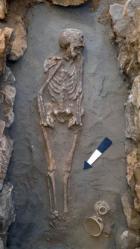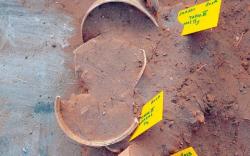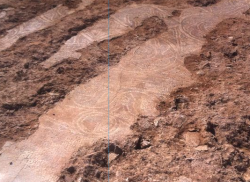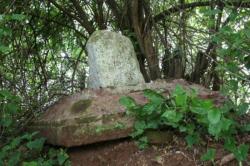- 19 SEPTEMBRE
- INDI-UNI : ANTHROPOLOGY - ARCHAEOLOGY
REGISTRATION 2011 – 2012 ONLINE COURSES
INSCRIPTION 2011 – 2012 COURS A DISTANCE
GRECE – 
 Soha - A Mycenaean cemetery of the 14th c. B.C. revealed itself after a heavy rainfall in the Peloponnese, 10 km NW of Leonidion, near the village of Vaskina (Βασκίνα). It contained five graves.When the archaeologists of the 38th Ephorate of Prehistoric and Classical Antiquities proceeded with an excavation of the site they found the five cist-shaped graves, in which more than one dead had been buried. According to a declaration made by the head of the Ephorate, mrs Karapanagiotou, the locals discovered the outlines of the graves that had been uncovered by the rain and immediately informed the Archaeological service.
Soha - A Mycenaean cemetery of the 14th c. B.C. revealed itself after a heavy rainfall in the Peloponnese, 10 km NW of Leonidion, near the village of Vaskina (Βασκίνα). It contained five graves.When the archaeologists of the 38th Ephorate of Prehistoric and Classical Antiquities proceeded with an excavation of the site they found the five cist-shaped graves, in which more than one dead had been buried. According to a declaration made by the head of the Ephorate, mrs Karapanagiotou, the locals discovered the outlines of the graves that had been uncovered by the rain and immediately informed the Archaeological service.
Ceramic banqueting vessels of the kind usually found in graves, stone weaving weights and a bronze pin were among the offerings that accompanied the dead.However a cemetery signifies a settlement, which has yet to be discovered, but was obviously one of the many that flourished in the Peloponnese during the Mycenaean period.
http://archaeologymatters2.blogspot.com/2011/09/mycenean-cemetery-reveals-itself.html
- FRANCE – Saint Sylvestre sur Lot - Le sous-sol du lieu dit La Mariniesse a en effet dévoilé ces derniers mois des vestiges de l'âge de fer qui retiennent toute l'attention de la Drac (Direction régionale des affaires culturelles). On y a retrouvé les traces d'un habitat datant de 1 000 ans avant JC à l'an 200, comprenant notamment les restes d'une sépulture d'enfant datant de l'âge de fer (environ 700 avant JC). L'importance supposée de ce site archéologique a aussitôt incité la Direction régionale des affaires culturelles (Drac) à entreprendre des fouilles préventives sur une vaste échelle. Le chantier qui va débuter ce lundi prévoit de creuser sur une hauteur variant de 30 à 50 centimètres et sur une superficie de 3,20 ha. Ainsi, pendant trois à quatre mois, le site saint-sylvestrois va devenir l'un des plus importants chantiers de fouilles archéologiques à travers l'Aquitaine. Les recherches, menées par l'Institut national de recherches archéologiques préventives (Inrap) auront pour objet d'exhumer les traces d'une occupation humaine sur un millier d'années.
http://www.sudouest.fr/2011/09/19/le-passe-suspend-l-avenir-502850-3862.php
- ITALIE – Vinschgau - Des archéologues ont découvert une ferme romaine vieille d'environ 2000 ans dans la province alpine italienne du Haut-Adige (Sud-Tyrol en allemand). Cette "Villa rustica" était située sur l'ancienne Via Claudia Augusta, une des principales routes romaines des Alpes. Elle a été construite au cours du 1er siècle après Jésus-Christ, ont précisé samedi les archéologues de l'Université d'Innsbruck (ouest de l'Autriche, dans le Nord-Tyrol). L'équipe dirigée par le Professeur Gerald Grabherr a mis à jour la ferme romaine lors de fouilles préalables à la réalisation d'un système d'irrigation pour l'agriculture locale, près de Vinschgau. Sur place, les archéologues ont retrouvé des pièces de monnaie, des fibules, des morceaux de poterie en céramique ou en stéatite (silicate de magnésium naturel). De la vaisselle (terra sigillata) laisse penser que les habitants de la ferme étaient en contact avec des potiers du sud-est de la France.
http://www.romandie.com/news/n/Italie_decouverte_d_une_ferme_romaine_vieille_d_environ_2000_ans170920112109.asp
- ESPAGNE – 
 Barcelone - Depuis plusieurs semaines, les turpitudes de la construction de la ligne TGV Perpignan-Barcelone sont archéologiques dans la capitale catalane. Courant juillet, un site à haute valeur historique, contenant une imposante ville romaine, est apparu dans le chantier de la gare de la Sagrera, en cours au nord de la ville depuis février. En dépit du caractère unique de cette ancienne zone habitée dotée d'une piscine et de mosaïques, dont l'existence n'a été révélée que le 2 septembre, le chantier doit se poursuivre inexorablement. Ce choc entre le passé et l'avenir est accompagné à la hâte de prélèvements, prises de photographies scientifiques et inventaires, effectués quotidiennement par 60 archéologues, jusqu'à la tombée de la nuit. Cette villa, présente côté mer du noeud ferroviaire, sera sacrifiée par la poursuite de la construction de l'énorme gare prevue. Ce contretemps patrimonial s'ajoute à une découverte tout aussi surprenante, qui témoigne d'une période plus proche, mais n'a seulement été dévoilée ce vendredi. Des ossements contemporains de la Guerre des Faucheurs, déclenchée en 1640 et finalisée par la signature du traité des Pyrénées, en 1659, ont été identifiés au début de l'été. Douze fosses communes contenant les restes de soldats, datant de la fin du XVIIe au début du XVIIIe siècle, exigent là aussi un intense travail archéologique, qui stoppe net le chantier. Cet inconvénient technique concerne la partie haute de la Rambla Prim, où l'analyse de dizaines de corps débouchera, comme dans le premier cas, vers une exploitation assumée par le Musée d'Histoire de Barcelone. La découverte de monnaies, qui permet de dater les ossements, rend les fouilles aussi exaltantes qu'amères, car l'heure tourne, et la Ligne à Grande Vitesse n'attend plus, d'autant que d'autres découvertes ne sont pas exclues.
Barcelone - Depuis plusieurs semaines, les turpitudes de la construction de la ligne TGV Perpignan-Barcelone sont archéologiques dans la capitale catalane. Courant juillet, un site à haute valeur historique, contenant une imposante ville romaine, est apparu dans le chantier de la gare de la Sagrera, en cours au nord de la ville depuis février. En dépit du caractère unique de cette ancienne zone habitée dotée d'une piscine et de mosaïques, dont l'existence n'a été révélée que le 2 septembre, le chantier doit se poursuivre inexorablement. Ce choc entre le passé et l'avenir est accompagné à la hâte de prélèvements, prises de photographies scientifiques et inventaires, effectués quotidiennement par 60 archéologues, jusqu'à la tombée de la nuit. Cette villa, présente côté mer du noeud ferroviaire, sera sacrifiée par la poursuite de la construction de l'énorme gare prevue. Ce contretemps patrimonial s'ajoute à une découverte tout aussi surprenante, qui témoigne d'une période plus proche, mais n'a seulement été dévoilée ce vendredi. Des ossements contemporains de la Guerre des Faucheurs, déclenchée en 1640 et finalisée par la signature du traité des Pyrénées, en 1659, ont été identifiés au début de l'été. Douze fosses communes contenant les restes de soldats, datant de la fin du XVIIe au début du XVIIIe siècle, exigent là aussi un intense travail archéologique, qui stoppe net le chantier. Cet inconvénient technique concerne la partie haute de la Rambla Prim, où l'analyse de dizaines de corps débouchera, comme dans le premier cas, vers une exploitation assumée par le Musée d'Histoire de Barcelone. La découverte de monnaies, qui permet de dater les ossements, rend les fouilles aussi exaltantes qu'amères, car l'heure tourne, et la Ligne à Grande Vitesse n'attend plus, d'autant que d'autres découvertes ne sont pas exclues.
http://www.la-clau.net/info/barcelone-des-ossements-du-xviiie-siecle-stoppent-le-chantier-tgv-7136
- INDE –  Munjuluru - A hemispherical Buddhist stupa belonging to the Vajrayana period of Buddhism dating back to 6th and 7th Century A.D. was by chance unearthed by the Department of Archaeology of Andhra Pradesh last week following sighting of a large brick in the vicinity of a large mound in this village. The 10-metre (diametre) main stupa is now in a dilapidated state, but is yet another Buddhist site to get added to the four major ones in the district. Due to tilling activity some of the outer structures like aramas and ayakas have vanished. Some of the sculptures, bearing a distinct resemblance to the Amaravathi School of sculpting designs, now adorn some common places of the villages as Hindu deities such as Jambala (Kubera). The villagers considered it a vintage temple of Lord Shiva in a barren land of about 1 acre on the village outskirts. The stupa with Ayaka pillars in a hemispherical shape was found adjacent to the Zilla Parishad High School. The village derives its name from Buddhist bikshus, whom the locals used to call ‘Munulu' (sages) and thus the name Munuluru which over the years turned into Munjuluru. Additional Director of Archaeology and Museums K. Chitti Babu, who visited the site along with The Hindu team, said that the stupa belonged to the last phase of the Buddhism (Vajrayana Buddhism practised in Tibet and Mongolia). He said the barren area, covering many acres close to the stupa, was littered with Buddhist cultural remains. The archaeologist also collected a number of red and black pottery, including rims in different shapes and sizes. The black, red and scarlet buffed ware, along with conical shaped bowls with heaps of lime conch shells used for plastering during the construction of the stupa, were collected and recorded by Mr. Babu. The stupa is built with bricks made of husk measuring 23 cm width, 7 cm height and 28 cm length — a typical Buddhist construction material of that period. One of the ayaka pillars, which is in octagonal shape, was perched on a square base. However, for the locals it is a dilapidated Shiva temple.
Munjuluru - A hemispherical Buddhist stupa belonging to the Vajrayana period of Buddhism dating back to 6th and 7th Century A.D. was by chance unearthed by the Department of Archaeology of Andhra Pradesh last week following sighting of a large brick in the vicinity of a large mound in this village. The 10-metre (diametre) main stupa is now in a dilapidated state, but is yet another Buddhist site to get added to the four major ones in the district. Due to tilling activity some of the outer structures like aramas and ayakas have vanished. Some of the sculptures, bearing a distinct resemblance to the Amaravathi School of sculpting designs, now adorn some common places of the villages as Hindu deities such as Jambala (Kubera). The villagers considered it a vintage temple of Lord Shiva in a barren land of about 1 acre on the village outskirts. The stupa with Ayaka pillars in a hemispherical shape was found adjacent to the Zilla Parishad High School. The village derives its name from Buddhist bikshus, whom the locals used to call ‘Munulu' (sages) and thus the name Munuluru which over the years turned into Munjuluru. Additional Director of Archaeology and Museums K. Chitti Babu, who visited the site along with The Hindu team, said that the stupa belonged to the last phase of the Buddhism (Vajrayana Buddhism practised in Tibet and Mongolia). He said the barren area, covering many acres close to the stupa, was littered with Buddhist cultural remains. The archaeologist also collected a number of red and black pottery, including rims in different shapes and sizes. The black, red and scarlet buffed ware, along with conical shaped bowls with heaps of lime conch shells used for plastering during the construction of the stupa, were collected and recorded by Mr. Babu. The stupa is built with bricks made of husk measuring 23 cm width, 7 cm height and 28 cm length — a typical Buddhist construction material of that period. One of the ayaka pillars, which is in octagonal shape, was perched on a square base. However, for the locals it is a dilapidated Shiva temple.
http://www.thehindu.com/news/national/article2465454.ece
- ROYAUME UNI – Caerleon - A team of Cardiff University staff and students have undertaken a month long archaeological dig at the Roman fortress of Caerleon, in Newport. It is hoped that the dig will uncover new information about the buildings that once stood on the site. The excavation, which started on August 4th, follows the finding of a previously undiscovered suburb outside the walls of the Caerleon fortress, also by Cardiff University School of History, Archaeology and Religion (SHARE). The research, carried out in spring 2010, had found evidence of a variety of large buildings, which could include markets, bath houses, and a quayside wall. The results of the study had indicated that the area could have been the centre of a town or city, due to the quantity and the arrangement of the buildings. However, it also showed little evidence that a large civilian population had lived there. Dr Peter Guest, from SHARE, said that the excavation of the area should help to answer questions, such as this, about the role of the site in Roman Britain. “When was it built? What were the buildings for? Who were the people using them and what happened to them after the legion left Caerleon? That’s what we’re hoping our excavation of this important site will tell us.” He said of the buildings: “The biggest is enormous and must be one of the largest buildings known from Roman Britain.”
http://www.gairrhydd.com/news/19/09/2011/cardiff-led-roman-excavation
- AUSTRALIE – Penola - Archaeologists will dig at the old stable site where Saint Mary MacKillop started her first school in South Australia, as the first anniversary of her canonisation approaches.St Mary of the Cross opened her first school in Penola in 1866 and it was there she chose to devote her life to God and to providing a future for the poorest and most marginalised people.As the anniversary of her October 17, 2010 canonisation draws near, 15 staff and students from Flinders University will this weekend begin digging to see if they can find artefacts and other historical materials at the stable site.
http://news.ninemsn.com.au/national/8303921/dig-to-start-on-saintly-site
- SINGAPOUR - While Singapore now has its first archaeological research unit, veterans said much more groundwork needs to be done to take the field further. The Archaeological Unit of the Nalanda-Sriwijaya Centre at the Institute of Southeast Asian Studies (Iseas) was inaugurated by former president S R Nathan last month.
http://www.straitstimes.com/BreakingNews/Singapore/Story/STIStory_714456.html
- INDE – Nagaland - Eminent educationalist, Fr A.J Sebastian Sab, HoD English Dept Nagaland University, urged the teachers and students to write and publish articles through local newspaper which serves as the best platform. Citing archaeological exploration in Nagaland, he said community research basing on oral tradition was used while excavating Naga ancestral sites which dates back to 50 BC- 90 A.D at Phor Village under Meluri sub-division, Laluri dated at 670-1000 AD, Khezhakeno dated 1320-1500 A.D, Jotsma at 1650.
He said archaeological research was done at the best interest of the villagers and felt that maximum benefit go to the village.
http://www.nagalandpost.com/ChannelNews/State/StateNews.aspx?news=TkVXUzEwMDAwNTk0Nw%3D%3D-d5wVAypTszY%3D